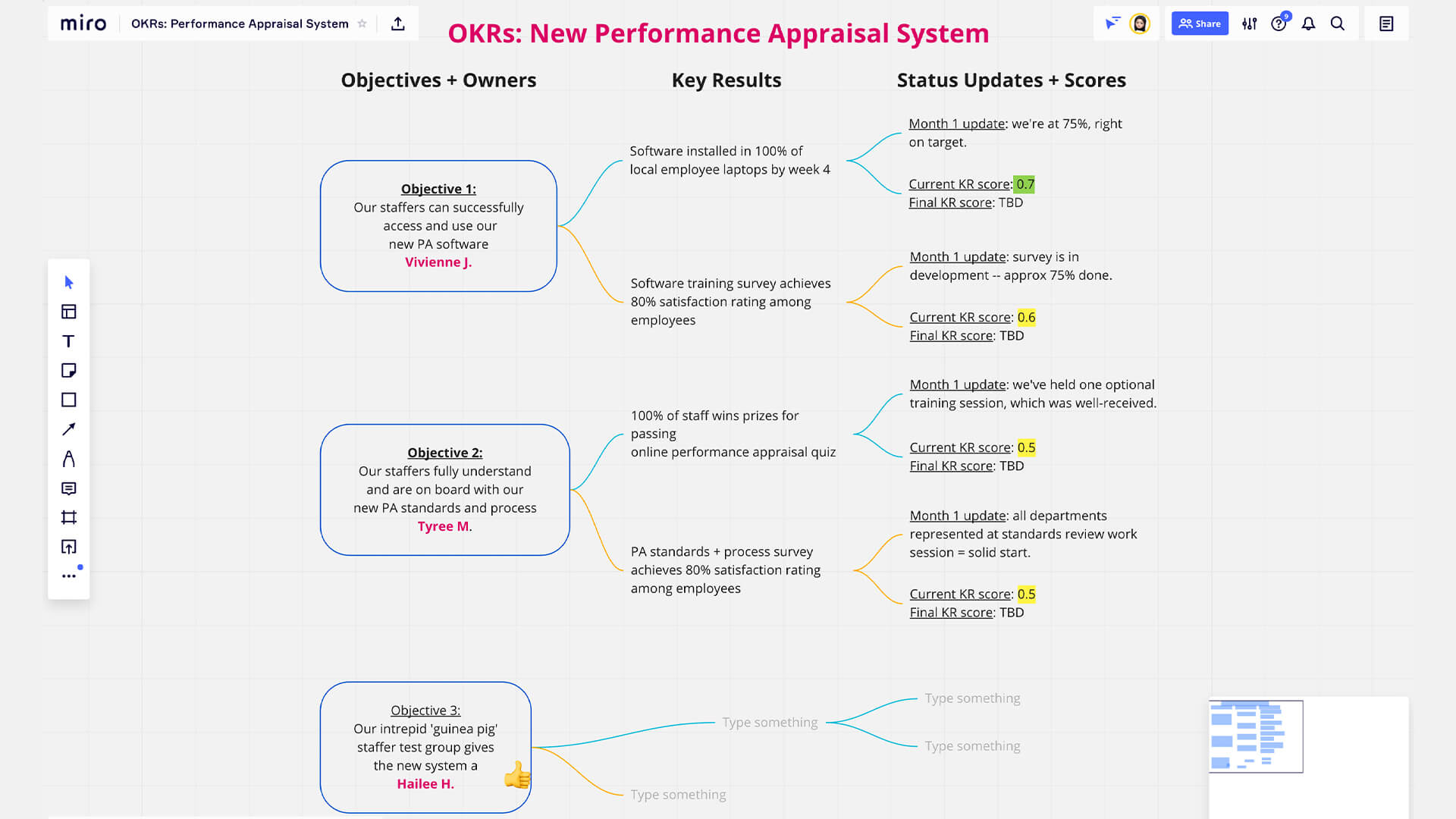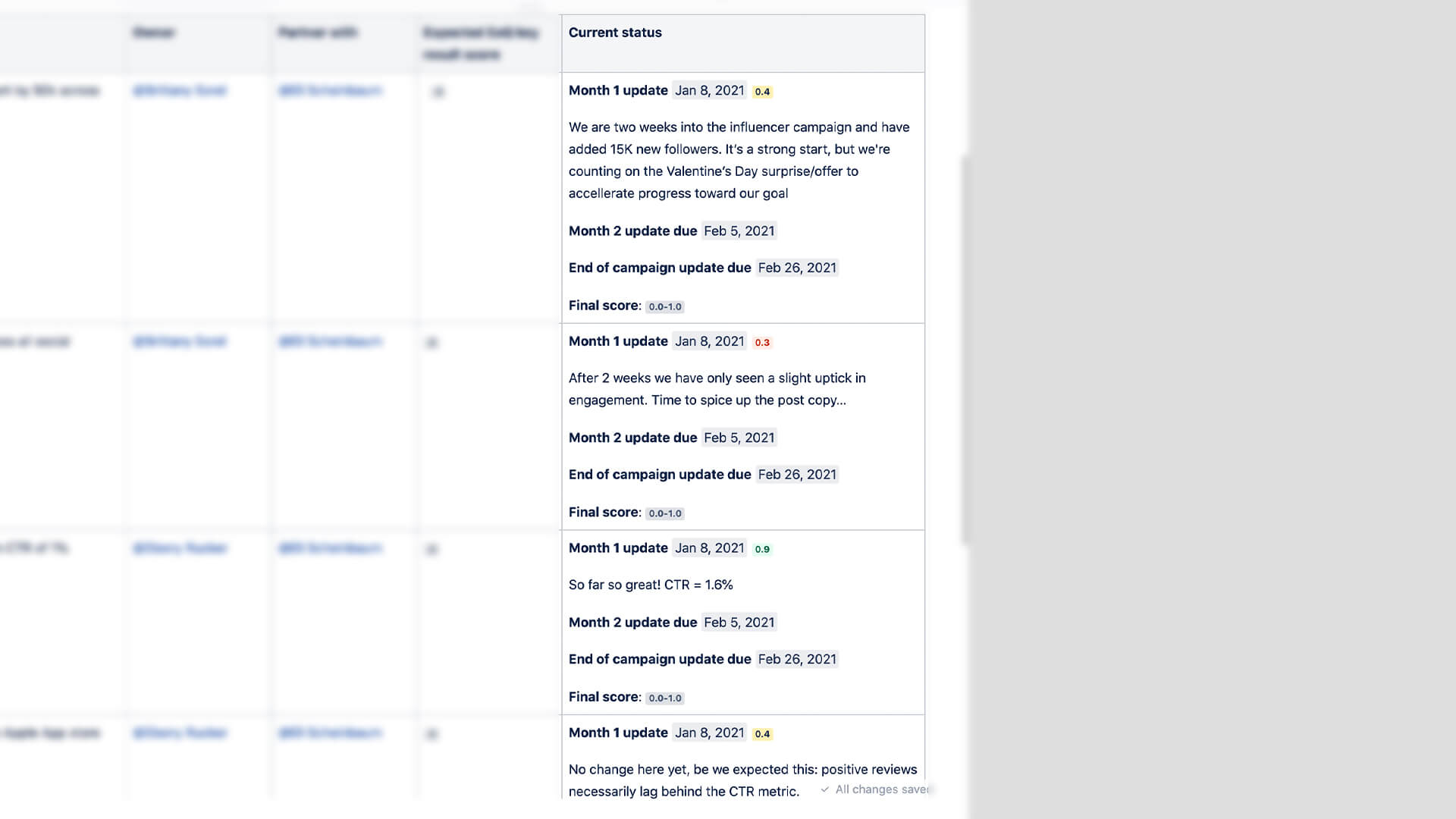Objectives and Key Results (OKRs)
Use the OKR goal-setting framework to define objectives, establish key results, and accelerate progress toward achieving your organizational and team goals.

PREP TIME
10m
Run TIME
2h
Persons
3-11
5-second summary
- Define 1-3 objectives.
- Set 3-5 key results per objective.
- Track success and score your OKRs each month.
WHAT YOU WILL NEED
- Video conferencing with screen sharing or meeting space.
- Digital collaboration tool (see templates).
- Timer.
PLAY resources
How to set OKRs
The OKR Play shares a five-step process that any team can follow to define objectives, articulate desired results, and track success with OKRs.
O que são Objetivos e Principais Resultados (ORCs)?
John Doerr, que falou em ORCs pela primeira vez no livro Medir o que importa, define objetivos como o "o quê" e os principais resultados como o "como". A gente vai explicar melhor.
Objetivos representam o que você quer alcançar e indicam a direção ou o alvo. Em geral, são qualitativos, ambiciosos e servem para inspirar a ação.
Principais resultados mostram como você vai alcançar os objetivos com resultados específicos e mensuráveis. São quantitativos e acompanham o progresso em direção aos objetivos, em geral com métricas ou marcos claros.
Já os ORCs são mais poderosos quando implementados em toda a empresa, pois são escalonados entre equipes e indivíduos.
Por que seguir uma tática de ORC?
Confira dois fortes motivos para implementar táticas de ORC:
- Determinar o que importa: ORCs deixam claro o que é prioritário e como o trabalho contribui para esses objetivos organizacionais.
- Determinar o que não importa: ORCs esclarecem o que não é prioritário, além de capacitarem equipes a se concentrarem em um conjunto limitado de prioridades e rejeitarem tarefas que distraiam do trabalho principal.
ORCs alinham equipes em torno de metas, promovem a transparência, incentivam a responsabilidade e servem como uma estrutura clara para mensurar o sucesso. Quando implementados do jeito certo, os ORCs impulsionam um melhor desempenho e colaboração em toda a empresa.
Quando usar ORCs no trabalho
ORCs são úteis durante períodos de crescimento, mudança ou quando há necessidade de melhorar a transparência e a responsabilidade na empresa. As equipes da Atlassian definem ORCs a cada ano, atualizam a cada trimestre e acompanham o progresso todo mês.
3 Benefícios dos ORCs
- Impacto positivo: 83% dos participantes da pesquisa concordam que os ORCs tiveram e continuam tendo um impacto positivo na empresa (Relatório do impacto dos ORCs em 2022).
- Produtividade maior e alcance de metas: equipes que priorizam o trabalho têm 4,6 vezes mais chances de serem eficazes e produtivas (Relatório da Atlassian sobre o estado das equipes em 2024).
- Agilidade e adaptabilidade: ORCs permitem ajustes rápidos de metas, o que ajuda empresas a se adaptarem às mudanças com agilidade. Identificar as principais metas torna as empresas 4,7 vezes mais propensas a se adaptarem (Relatório da Atlassian sobre o estado das equipes em 2024).
1. Prep the Play
1. Prepare a tática 5 min
Ao se reunir com a equipe, seja presencial ou remota, envie uma mensagem explicando a tática e o motivo para seguir essa estratégia. Depois, crie um documento de colaboração, como uma página do Confluence. Você pode usar os templates disponíveis ou criar um próprio.
Como equipe, decidam o período para definir ORCs (por trimestre é um bom começo) e compartilhem as seguintes informações antes de executar a tática:
- Objetivos e metas mais amplos da empresa
- Roteiros do projeto
- Métricas e/ou feedback de clientes
-
Se disponíveis, ORCs anteriores
DICA: ORIENTADO PELOS MELHORES
Caso a empresa não tenha ORCs, procure pelas iniciativas estratégicas ou grandes projetos do ano. Esses dados devem informar os ORCs que você está definindo como equipe.
2. Define objectives
1. Prepare a tática 5 min
Peça para a equipe fazer um brainstorming de objetivos: o que querem alcançar em um período definido. Os objetivos precisam ser qualitativos e ambiciosos, além de servir como as prioridades mais altas da equipe enquanto estiverem em vigor.
Adicione as ideias ao documento de colaboração. Agrupe objetivos semelhantes e resuma as ideias em um a três objetivos.
1. Melhorar a satisfação do cliente
2. Acelerar o desenvolvimento de produtos
3. Expandir o alcance no mercado
4. Aumentar a produtividade da equipe
5. Construir para o futuro
6. Conquistar corações e mentes
7. Virar uma empresa de IA
8. Promover o engajamento de produtos prioritários
9. Expandir a adoção das equipes de negócios
10. Aumentar a receita de vendas
3. Set key results
1. Prepare a tática 5 min
Peça para cada pessoa identificar quais são as principais responsabilidades que assumem no projeto (de 3 a 5) na coluna "Responsabilidades (o que penso)".
1. Objetivo: melhorar a satisfação do cliente
- Principal resultado 1: alcançar um Net Promoter Score (NPS) de 50 ou mais
- Principal resultado 2: reduzir o tempo médio de resposta às consultas dos clientes para menos de 2 horas
-
Principal resultado 3: aumentar a taxa de retenção de clientes em 10%
2. Objetivo: acelerar o desenvolvimento de produtos
- Principal resultado 1: lançar duas novas funções até o final do quarto trimestre
- Principal resultado 2: reduzir o tempo médio de resolução de bugs em 25%
-
Principal resultado 3: aumentar o percentual de testes automatizados para 80%
3. Objetivo: expandir o alcance no mercado
- Principal resultado 1: entrar em três novos mercados geográficos até o final do ano
- Principal resultado 2: aumentar o reconhecimento da marca em 20% nos mercados-alvo
-
Principal resultado 3: garantir parcerias com cinco influenciadores ou empresas importantes
DICA: RESULTADOS, NÃO TAREFAS
Os principais resultados são uma medida de trabalho, não o trabalho em si.
“Criar 5 páginas da Web” é trabalho.
"Aumento de 5% nas visualizações de página" é um principal resultado.
DICA: PROTEJA A QUALIDADE
Os principais resultados precisam incluir tanto o resultado quanto a qualidade. Por exemplo, se o principal resultado for o número de tickets resolvidos da central de ajuda, você também pode mensurar a diminuição de tickets enviados para garantir a qualidade do suporte. A meta não é atingir o principal resultado em detrimento da qualidade.
4. Assign owners
1. Prepare a tática 5 min
Para as outras funções identificadas, anote as principais responsabilidades de cada uma na coluna "Responsabilidades (o que os outros pensam)".
Se você pensar em responsabilidades que não se encaixam com clareza em uma função, elas devem ser adicionadas à seção de responsabilidades não atribuídas.
5. Tracking success with OKRs
1. Prepare a tática 5 min
Analise o que outras pessoas escreveram sobre a função que você assume na coluna "Responsabilidades (o que os outros pensam)". Adicione ✅ se aceitar ou ❌ se não aceitar cada responsabilidade.
Adicione comentários em linha se tiver perguntas ou comentários sobre as responsabilidades de outras pessoas.
Após conversar com a equipe, o titular da função vai analisar todos os ❌ e decidir se deve assumir ou delegar tarefas adicionais. Em casos de sobreposição de tarefas, o proprietário principal é designado, com possíveis colaboradores ou proprietários de backup.
As responsabilidades não reivindicadas ou não aceitas vão ser transferidas para a seção "não atribuída".
A depender da estrutura organizacional, pode ser que o titular da função precise da aprovação da liderança para finalizar a função, conforme descrito nesse processo.
Follow-up
Compartilhe
Compartilhe o documento final com a equipe para receber feedback sobre possíveis lacunas ou oportunidades.
Distribua o documento de funções e responsabilidades para as principais partes interessadas e líderes, informando a equipe sobre essa ação.
Analise a tática com a equipe a cada três ou seis meses, ou sempre que houver alterações importantes na equipe. A prática regular vai facilitar o processo.

Ainda tem dúvidas?
Inicie conversas com outros usuários do Esquema Tático da Atlassian, receba suporte ou forneça feedback.
Other plays you may like
Tomada de decisão
Estrutura de tomada de decisões DACI
Atribua funções claras para garantir a efetividade da colaboração e responsabilidade durante o processo de tomada de decisões.
Tomada de decisão
Balanço
Defina e priorize as variáveis do projeto.
Goal-setting
Modeling Strategic Focus Areas
Build and align on your organization’s strategic focus areas.
Mantenha-se atualizado
Receba as últimas dicas sobre táticas e vida profissional ao se inscrever em nossa newsletter.










